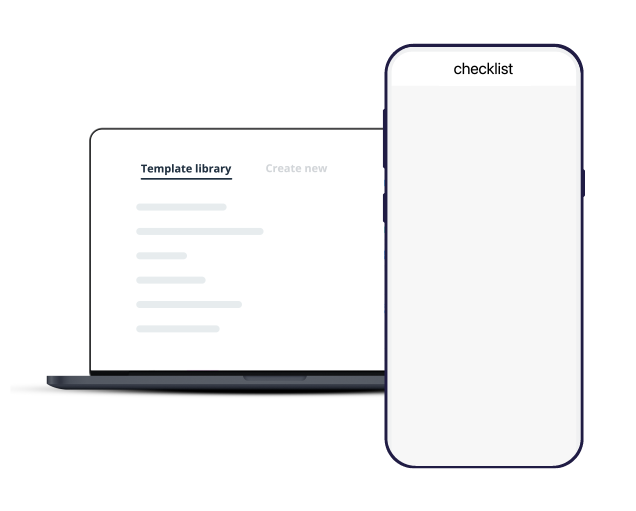Use our construction safety inspection checklist template as a starting point to customize yours to fit your company.
Construction Safety Inspection Checklist

Make work flow with Connecteam’s digital forms & checklists
- Easily create digital forms and checklists for any task your team needs to complete on the job
- Boost accountability by having employees add a signature, image, or location stamp
- Save time by choosing from a variety of ready-made templates
- Instantly receive your team’s submissions and share reports within your organization
- Use AI to convert PDFs, Excel files, or images into digital forms in seconds—no manual work needed

Construction Safety Inspection Checklist
This construction safety inspection checklist aims to promote a safe working environment on construction sites by identifying potential hazards and ensuring compliance with safety regulations.
Regular safety inspections help prevent accidents and injuries, protecting both workers and the public.
Construction site supervisors and safety officers can use this checklist to assess safety practices and implement corrective measures promptly.
Project Information:
Project Name:
Project Location:
Date of Inspection:
Inspector’s Name:
Site Preparation:
General Site Safety:
[ ] Ensure the presence of safety signage, including warning signs, hazard symbols, and safety guidelines.
[ ] Check that access points are clearly marked and free of obstructions.
[ ] Verify that emergency contact numbers and first aid supplies are readily accessible.
[ ] Inspect the availability and condition of personal protective equipment (PPE) for all workers.
[ ] Review safety training records to ensure all workers have received appropriate training.
Fall Hazards:
[ ] Inspect scaffolding, ladders, and elevated work platforms for proper setup and stability.
[ ] Check that guardrails and toe boards are in place on elevated work areas.
[ ] Verify the use of fall arrest systems for workers operating at heights.
[ ] Inspect floor openings and edges to ensure proper barricading or covers are in place.
[ ] Review fall protection plans and procedures for compliance with safety standards.
Electrical Safety:
[ ] Inspect electrical cords and equipment for damage or wear.
[ ] Check that electrical outlets and panels are properly covered and labeled.
[ ] Verify grounding and bonding for electrical safety.
[ ] Ensure the use of Ground Fault Circuit Interrupters (GFCIs) where required.
[ ] Review lockout/tagout procedures for electrical equipment maintenance.
Fire Safety:
[ ] Verify the presence and accessibility of fire extinguishers in designated areas.
[ ] Check that fire exits and evacuation routes are clearly marked and unobstructed.
[ ] Inspect fire alarms and smoke detectors to ensure they are in working condition.
[ ] Review the availability and use of fire-resistant materials in high-risk areas.
[ ] Check that welding and hot work are conducted in designated safe zones.
Hazardous Materials Handling:
[ ] Inspect storage areas for hazardous materials, ensuring proper containment and labeling.
[ ] Verify the use of appropriate Personal Protective Equipment (PPE) when handling hazardous materials.
[ ] Check that Material Safety Data Sheets (MSDS) are readily available for all hazardous substances.
[ ] Review spill response plans and procedures for hazardous materials incidents.
[ ] Ensure proper disposal of hazardous waste according to regulations.
Heavy Equipment and Machinery Safety:
[ ] Verify that operators of heavy equipment and machinery are qualified and trained.
[ ] Inspect equipment and machinery for proper maintenance and operational safety features.
[ ] Check that machine guarding is in place to prevent contact with moving parts.
[ ] Ensure clear communication methods between equipment operators and ground personnel.
[ ] Review procedures for safe equipment startup and shutdown.
Excavation and Trenching Safety:
[ ] Inspect excavation sites for proper shoring and bracing.
[ ] Verify that workers wear appropriate PPE while working in excavations.
[ ] Check for the presence of ladders or safe access points for workers in trenches.
[ ] Review confined space entry procedures for excavations.
[ ] Ensure that excavation sites are barricaded to prevent unauthorized access.
Personal Protective Equipment (PPE) Compliance:
[ ] Check that workers are wearing appropriate PPE based on their job tasks.
[ ] Verify that PPE is well-maintained and free from defects or damage.
[ ] Review training records to ensure workers are trained on the proper use of PPE.
[ ] Ensure that visitors and contractors are provided with necessary PPE when on-site.
[ ] Inspect the availability and proper use of respiratory protection, if applicable.
Emergency Preparedness:
[ ] Verify the presence of a documented emergency response plan.
[ ] Inspect emergency exits and evacuation routes for clear signage and accessibility.
[ ] Ensure that all workers are familiar with emergency procedures and evacuation routes.
[ ] Review the availability and functionality of emergency response equipment, such as first aid kits and AEDs.
[ ] Conduct regular emergency drills to assess response readiness.
This construction safety inspection checklist is a crucial tool for maintaining a safe and secure construction site.
Regular safety inspections and prompt corrective actions help prevent accidents and injuries, fostering a culture of safety and compliance within the construction industry.
Site supervisors and safety officers should prioritize safety and use this checklist as a guide to address potential hazards and promote the well-being of all workers involved in the construction process.
Choose Connecteam, the #1 Choice for Safety Inspectors
Connecteam is the ultimate tool that can significantly enhance your performance, streamlining your tasks and boosting productivity.
With our user-friendly mobile app, you can easily create and access construction inspection checklists, ensuring every aspect of the project is thoroughly examined.
Empower yourself with our real-time reporting feature, allowing you to document findings instantly, complete with photos and notes, and enabling efficient communication with project managers and stakeholders.
Plus, our smart employee scheduling and employee task tracking capabilities help you optimize work plans, ensuring timely inspections and minimizing delays.
Experience a game-changing solution tailored to your inspection needs!
📚 You might be interested in reading:
- The top employee tracking apps for 2025
- The best clock in clock out app of 2025
- The best employee scheduling apps of 2025
Get started with Connecteam for free today and enjoy seamless checklists, instant reporting, and efficient collaboration with your team.
Watch the video below to see it in action:

Ready to boost your efficiency with our pre-made templates?